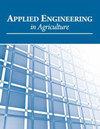Data Quality Control for Stationary Infrared Thermometers Viewing Crops
IF 0.9
4区 农林科学
Q4 AGRICULTURAL ENGINEERING
引用次数: 0
Abstract
Highlights A quality control procedure was developed for infrared thermometer data. The procedure included ten tests that can identify data quality conditions. The test results were subject to criteria to recommend which data to use. Test data included six crop seasons and fallow periods. 56% of the data passed the test for the highest level of data quality. Abstract . The increased adoption of infrared thermometers (IRTs) for irrigation management of crops has resulted in increasingly large surface temperature datasets, resulting in a need for data quality assurance and control (QA/QC) procedures similar to those developed for agricultural weather station data. A QC procedure was developed to test for seven common data conditions, including sensor not deployed, missing, too high, too low, upward spike, downward spike, or stuck. The conditions of “too high” or “too low” used a simple energy balance procedure similar to the crop water stress index, where the theoretical lower and upper temperature limits of a surface were calculated, accounting for the vegetation view factor appearing in the IRT field-of-view. After passing the seven tests, data were assigned as Plausible, and further tested as Confirmed or Confirmed+. The Confirmed test compared each IRT to the median of the other IRTs during 2 h before sunrise and applied a threshold of ±0.5°C. The Confirmed+ test compared each IRT to the median of the other IRTs during ±2 h of solar noon and applied a threshold of ±2.0°C. The set of tests was applied to an IRT dataset that included six seasons of crops and fallow periods with 15-min time steps. Temperature differences greater than the thresholds (i.e., assigned Plausible but not Confirmed or Confirmed+) could detect anomalies including ice, dirty or obscured lenses, or biased data that other tests did not detect. Of all time intervals when 20 IRTs viewing a crop were deployed, 80% resulted in Plausible, 61% resulted in Confirmed, and 56% resulted in Confirmed+. The procedure can be easily customized and can increase the value of IRT datasets used for irrigation management. Keywords: Canopy temperature, Infrared thermometer, QA/QC, Quality assurance, quality control, Test, Weather data.固定式红外测温仪观测作物的数据质量控制
重点介绍了红外测温仪数据的质量控制程序。该程序包括十个可以识别数据质量条件的测试。测试结果取决于推荐使用哪些数据的标准。试验数据包括六个作物季节和休耕期。56%的数据通过了最高级别的数据质量测试。摘要越来越多地采用红外温度计(IRTs)进行作物灌溉管理,导致地表温度数据集越来越大,因此需要类似于农业气象站数据开发的数据质量保证和控制(QA/QC)程序。开发了一个QC程序来测试7种常见的数据条件,包括传感器未部署、缺失、过高、过低、向上尖峰、向下尖峰或卡住。“过高”或“过低”的条件使用了类似于作物水分胁迫指数的简单能量平衡程序,其中计算了地表的理论下限和上限,考虑了IRT视场中出现的植被视图因子。通过七项测试后,将数据分配为似是而非,并进一步测试为已确认或已确认+。确认测试在日出前2小时将每个IRT与其他IRT的中位数进行比较,并应用±0.5°C的阈值。在正午±2小时内,Confirmed+测试将每个IRT与其他IRT的中位数进行比较,并应用±2.0°C的阈值。这组测试应用于IRT数据集,该数据集包括六个作物季节和休耕期,每15分钟的时间步长。大于阈值(即指定的似是而非确认或确认+)的温差可以检测到异常,包括冰、脏或模糊的透镜,或其他测试未检测到的有偏差的数据。在所有的时间间隔中,当部署20个irt来观察作物时,80%的结果是可信的,61%的结果是确认的,56%的结果是确认+。该程序可以很容易地定制,并且可以增加用于灌溉管理的IRT数据集的价值。关键词:冠层温度,红外测温仪,QA/QC,质量保证,质量控制,测试,气象数据
本文章由计算机程序翻译,如有差异,请以英文原文为准。
求助全文
约1分钟内获得全文
求助全文
来源期刊

Applied Engineering in Agriculture
农林科学-农业工程
CiteScore
1.80
自引率
11.10%
发文量
69
审稿时长
6 months
期刊介绍:
This peer-reviewed journal publishes applications of engineering and technology research that address agricultural, food, and biological systems problems. Submissions must include results of practical experiences, tests, or trials presented in a manner and style that will allow easy adaptation by others; results of reviews or studies of installations or applications with substantially new or significant information not readily available in other refereed publications; or a description of successful methods of techniques of education, outreach, or technology transfer.
 求助内容:
求助内容: 应助结果提醒方式:
应助结果提醒方式:


